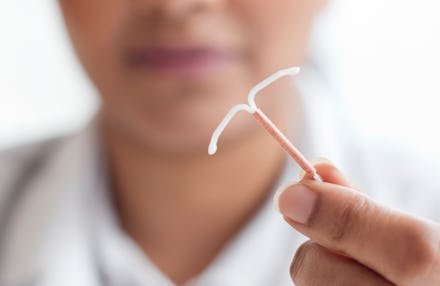Why people are pulling out their own IUDs on TikTok

TikTok has gained notoriety as a birthplace of gross, extremely ill-advised tutorials on everything from how to file your teeth into creepy Gremlin fangs to injecting your lips with filler. In one of the latest cringe-y how-to’s to drop on the platform, TikTokers are teaching people how to pull out their own IUDs. But while it might be easy to brush this off as yet another Gen Z trend, the motivation behind it — steep barriers that include doctors refusing to remove the devices — raise serious questions about patient autonomy, especially when those patients happen to have uteruses.
These issues entered the national conversation earlier this summer, when Britney Spears revealed in a testimony about her conservatorship that she wasn’t allowed to remove her IUD, Insider pointed out. "It took a horror story like Britney's to show that these methods that we love can be used in a very bad way," Diana Greene Foster, a demographer and research director at the University of California San Francisco, told the outlet.
In 2009, the American College of Obstetricians and Gynecologists deemed IUDs the leading form of birth control, Insider explained, preventing pregnancy for up to a decade. Since then, OB-GYNS have largely pushed for patients to not only get them, but keep them in until they expire. Yet some want to remove them before then because the side effects are unbearable, they want to become pregnant, or just prefer to be off birth control.
They face numerous obstacles to doing so. YouTuber Paige LeAnn of Alabama told Insider that her IUD caused side effects like cramping, weight gain, and depression. Yet when she asked health providers to remove it after two years, they essentially gaslit her, with one doctor suggesting she get an evaluation for anxiety instead.
Besides doctors not believing them, cost can also deter people from getting their IUDs removed. While insertion is free, according to Insider, removal is not, with one recent study calculating that it can cost $262 on average. Not all insurance plans cover it, either.
Martisha Perry, a student at the University of Georgia, told Insider that her IUD side effects included heavy periods, arthritic flare-ups, and intense cramps. But removing it would've cost her $175, not to mention a co-pay, which she couldn’t afford.
That’s why Perry, LeAnn, and others have taken matters into their own hands, pulling out their IUDs themselves and teaching others to do the same by posting how-to videos on TikTok and YouTube. Some see self-removal as empowering. Briana, a.k.a. @bri_and_layla_ on TikTok, said “it was so much less painful than having the doctor insert a speculum to remove it,” per Insider, and allowed her to “go at [her] own pace.”
Many health experts believe self-removal is safe for the most part, although Foster emphasized the importance of wearing gloves and either squatting or lying down while doing so. “I would be concerned if they were posting videos about something that was harmful, but I have not seen any evidence that removing your own IUD is harmful,” said Foster, who’s removed her device. Amid growing evidence of the safety of self-removals, some OB-GYNs have started talking about it with their patients.
That said, removal can be painful for some people, whether performed by themselves or a health provider, per Insider, possibly due to factors such as pre-existing pelvic pain or past trauma. The risk factors for IUD pain remain unclear. Scientists know little about the pain associated with insertion, and even less about the pain associated with removal.
Regardless, the fact that people need to resort to something as squeamish as pulling out their own IUDs is clearly a problem. No one should have to face so many obstacles to getting the healthcare they deserve that they have no other option but to treat themselves. As Foster pointed out, avoiding side effects and having control over when we want to even be on contraceptives should be considered as important as preventing pregnancy. Our reproductive futures shouldn’t depend on our finances, or a healthcare model as steeped in the patriarchy as ours.